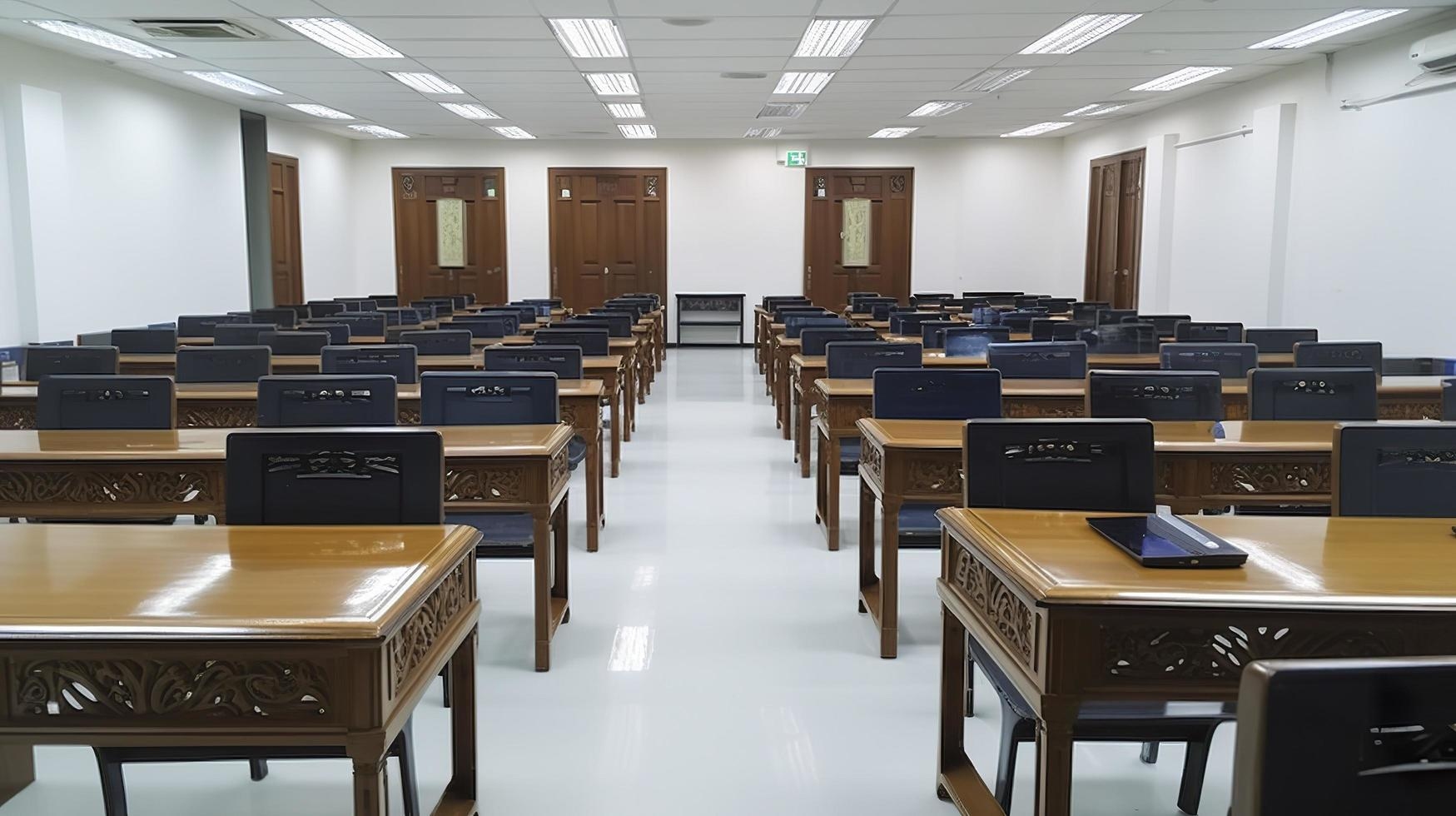
Creating an Inspiring Classroom Setting for Preschoolers
A classroom setting plays a vital role in shaping the educational experience for preschoolers. It serves as a space where young learners can explore, discover, and grow. A well-designed and engaging classroom environment supports their holistic development, fosters a love for learning, and lays the foundation for a successful educational journey. In this article, we will explore the key elements of an inspiring classroom setting that caters to the unique needs of preschoolers.
Classroom Layout and Organization
The layout and organization of a classroom greatly impact preschoolers’ learning experiences. A thoughtfully designed space promotes a sense of belonging, facilitates engagement, and encourages independence. Here are some essential considerations for classroom layout and organization:
1. Learning Zones: Creating distinct learning zones within the classroom helps preschoolers understand the different areas for various activities. These zones can include reading corners, writing centers, art stations, and quiet spaces for reflection. Clearly defined spaces make it easier for preschoolers to navigate the classroom and engage in activities independently.
2. Classroom Materials: An inspiring classroom setting is rich in age-appropriate learning materials. Teachers should provide a wide range of manipulatives, books, puzzles, and art supplies that encourage exploration, creativity, and hands-on learning. Displaying materials in an organized and accessible manner ensures preschoolers can easily locate and utilize them during their learning activities.
3. Traffic Flow: A well-designed classroom allows for smooth traffic flow, minimizing distractions and disruptions. Teachers should arrange furniture and learning materials strategically to create clear pathways for preschoolers to move around the classroom safely. Consideration should be given to avoiding congestion and providing ample space for group activities and movement.
Classroom Decor and Aesthetics
The decor and aesthetics of a classroom contribute to its overall atmosphere and impact preschoolers’ mood and engagement. Creating an inviting and visually stimulating environment can inspire curiosity and create a positive learning atmosphere. Consider the following elements when decorating the classroom:
1. Colour Scheme: Choose a colour scheme that is visually appealing and promotes a sense of calmness and focus. Soft and warm colours, such as pastels, can create a soothing and welcoming environment. Incorporate pops of bright colours to add vibrancy and stimulate preschoolers’ interest.
2. Wall Displays: Displaying preschoolers’ artwork, learning charts, and educational posters on the walls provides visual cues and reinforces learning. Celebrate their achievements and create a sense of pride and ownership in the classroom by showcasing their work. Rotate displays regularly to maintain freshness and to reflect current learning topics.
3. Print-Rich Environment: Create a print-rich environment by incorporating labels, word walls, and literacy displays. Surround preschoolers with meaningful print that reflects their interests and supports literacy development. Use clear and legible fonts, large text size, and appropriate spacing to facilitate reading and letter recognition.
Learning Centers and Workstations
Learning centers and workstations are integral parts of an inspiring classroom setting. They provide opportunities for hands-on exploration, independent learning, and collaborative activities. Here are some key considerations for setting up learning centers and workstations:
1. Flexibility: Design learning centers and workstations with flexibility in mind. Allow for easy reconfiguration and adaptation to accommodate different learning activities and changing needs. Mobile furniture and adjustable tables can support flexibility, enabling preschoolers to work individually or collaboratively.
2. Interest Areas: Incorporate a variety of interest areas that cater to different aspects of development. Examples include a reading corner, block area, science exploration station, art studio, and dramatic play area. These interest areas encourage preschoolers to explore their passions, develop key skills, and engage in imaginative play.
3. Clear Instructions and Materials: Clearly label and organize materials within each learning center or workstation to promote independence and responsibility. Use visual cues, such as pictures and icons, alongside text instructions to support preschoolers’ understanding. Ensure materials are easily accessible and kept at an appropriate height for preschoolers to reach independently.
Technology Integration
Integrating technology into the classroom setting provides preschoolers with valuable opportunities for digital literacy, creativity, and engagement. Here are some considerations for technology integration:
1. Age-Appropriate Devices: Select age-appropriate devices, such as tablets or computers, that offer educational apps, interactive games, and multimedia resources. Ensure that the technology supports the curriculum and enhances learning experiences without becoming a distraction.
2. Accessible Charging and Storage: Set up a designated area for charging and storing devices to keep them organized and readily available for use. Implement a system that allows preschoolers to retrieve and return devices safely and with teacher supervision.
3. Digital Displays: Utilize interactive whiteboards or large screens to display digital content and enhance visual learning experiences. Digital displays can be used for multimedia presentations, virtual field trips, and interactive activities that actively engage preschoolers in learning.
Sensory Integration
Preschoolers learn and engage with their environment through their senses. Incorporating sensory experiences within the classroom setting can enhance their cognitive, physical, and emotional development. Consider the following sensory integration strategies:
1. Sensory Areas: Dedicate areas within the classroom for sensory experiences, such as a sensory table with materials like sand, water, or rice. Include sensory-friendly materials, such as cushions or bean bags, to create cozy and comfortable spaces for relaxation or quiet reflection.
2. Tactile and Manipulative Materials: Provide a variety of tactile and manipulative materials, such as playdough, kinetic sand, textured fabrics, and sensory balls. These materials allow preschoolers to engage in hands-on exploration, develop fine motor skills, and stimulate their senses.
3. Calming Elements: Incorporate calming elements, such as soft lighting, soothing music, and quiet corners, to create a peaceful and relaxing environment. These elements can help preschoolers regulate their emotions, reduce anxiety, and promote a sense of well-being.
Classroom Management Strategies
Effective classroom management strategies create a conducive learning environment and promote positive behavior among preschoolers. Here are some strategies for managing the classroom effectively:
1. Clear Expectations: Establish clear and age-appropriate expectations for behavior and learning. Communicate these expectations to preschoolers and involve them in setting classroom rules and routines. Consistency and reinforcement of positive behaviors are essential for a harmonious classroom.
2. Positive Reinforcement: Use positive reinforcement techniques, such as verbal praise, stickers, or rewards, to acknowledge and encourage preschoolers’ efforts and achievements. Celebrate their successes and create a positive and encouraging atmosphere that fosters self-esteem and motivation.
3. Transition Activities: Plan transition activities to smoothly move preschoolers from one activity or learning center to another. Engage them in songs, rhymes, or brief discussions to help them understand and prepare for the transition. Smooth transitions help maintain a structured and focused classroom environment.
Creating an inspiring classroom setting for preschoolers is a multifaceted task that requires careful thought, creativity, and a deep understanding of their developmental needs. By considering the layout and organization of the classroom, the decor and aesthetics, the incorporation of learning centers and workstations, technology integration, sensory experiences, and effective classroom management strategies, educators can cultivate an environment that nurtures preschoolers’ curiosity, engagement, and love for learning. A well-designed classroom setting becomes a springboard for their educational journey, fostering a lifelong passion for knowledge and growth.
Inclusive Practices in the Classroom Setting
Inclusive practices are essential for creating a classroom setting that values and supports the diverse needs of all preschoolers. Inclusive classrooms foster a sense of belonging, promote equality, and celebrate differences. Here are some key considerations for implementing inclusive practices in the classroom:
1. Universal Design: Adopt a universal design approach to ensure that the classroom environment is accessible and accommodating for all preschoolers, regardless of their abilities or needs. Consider factors such as furniture placement, lighting, acoustics, and mobility within the classroom. Incorporate assistive devices, visual supports, and other accommodations to support individual learning styles.
2. Varied Learning Materials: Provide a range of learning materials that cater to different learning styles, abilities, and interests. Offer alternative formats for books, such as braille or audio versions, and consider adaptive tools for preschoolers with physical disabilities. By offering diverse materials, preschoolers can engage in learning activities that suit their unique preferences and abilities.
3. Collaborative Learning: Encourage collaboration and cooperation among preschoolers to foster a sense of community and mutual respect. Create opportunities for group work, peer-to-peer learning, and inclusive games and activities. This promotes social interaction, empathy, and understanding among preschoolers, fostering an inclusive and supportive classroom environment.
4. Culturally Responsive Environment: Embrace and celebrate the cultural diversity present within the classroom. Display multicultural books, artifacts, and artwork that reflect the backgrounds of the preschoolers. Incorporate culturally diverse learning materials and activities that promote inclusivity and cultural appreciation. Encourage sharing and learning about different traditions, languages, and customs to create an inclusive and culturally rich classroom environment.
5. Individualized Support: Recognize and respond to the individual needs of each preschooler. Implement differentiated instruction, where teaching strategies and materials are tailored to meet the diverse learning needs of the preschoolers. Provide additional support through one-on-one instruction, small group activities, or individualized learning plans. Regularly assess and monitor progress to ensure that every child is receiving the necessary support and opportunities for growth.
6. Positive Language and Interactions: Use inclusive and positive language when communicating with preschoolers. Avoid using discriminatory or exclusionary terms and promote respectful interactions among the preschoolers. Encourage active listening, empathy, and understanding. Teach preschoolers about diversity, acceptance, and the importance of treating everyone with kindness and respect.
By incorporating inclusive practices in the classroom setting, educators create an environment that values and embraces the unique qualities of each preschooler. Inclusive classrooms promote equal opportunities for learning, foster positive social interactions, and empower all preschoolers to reach their full potential. Through a commitment to inclusivity, educators can create a supportive and nurturing classroom environment that celebrates diversity and cultivates a sense of belonging for every preschooler.
Please keep in mind that creating an inclusive classroom requires ongoing learning, reflection, and adaptation. Educators should continually seek professional development and collaborate with families and specialists to ensure that all preschoolers receive the support and accommodations they need to thrive in the classroom.
Creating a Safe and Positive Classroom Climate
A safe and positive classroom climate is crucial for preschoolers’ well-being, engagement, and overall learning experience. When preschoolers feel safe, supported, and respected, they are more likely to actively participate in activities, take risks, and develop positive relationships with their peers and teachers. Here are some key strategies for creating a safe and positive classroom climate:
1. Establish Clear Expectations: Clearly communicate behavioral expectations to preschoolers from the beginning. Develop a set of age-appropriate rules and discuss them as a class, allowing preschoolers to contribute their ideas. Reinforce these expectations consistently and provide reminders when needed. When preschoolers understand what is expected of them, they feel more secure and know the boundaries of acceptable behavior.
2. Encourage Open Communication: Create an environment where preschoolers feel comfortable expressing their thoughts, feelings, and concerns. Encourage open dialogue and active listening by providing opportunities for sharing and reflection. Establish regular class meetings or circle time to discuss topics relevant to their experiences, fostering a sense of belonging and community.
3. Foster Positive Relationships: Develop strong relationships with each preschooler based on trust, respect, and empathy. Get to know their individual interests, strengths, and challenges. Use positive reinforcement, such as praise and encouragement, to acknowledge their efforts and achievements. Encourage peer interactions and teach social-emotional skills to support positive relationships among preschoolers.
4. Conflict Resolution Strategies: Teach preschoolers strategies for resolving conflicts in a peaceful and respectful manner. Help them understand the importance of listening, compromise, and empathy. Encourage problem-solving discussions and guide them towards finding mutually beneficial solutions. By providing them with the tools to manage conflicts, you empower them to develop essential social skills.
5. Promote Inclusivity and Acceptance: Create an atmosphere of inclusivity, acceptance, and respect for diversity. Celebrate differences in cultures, abilities, and backgrounds. Incorporate materials and activities that highlight diverse perspectives and experiences. Teach preschoolers about empathy, kindness, and the importance of treating everyone with fairness and respect.
6. Safe Physical Environment: Ensure that the classroom environment is physically safe for preschoolers. Regularly inspect materials and equipment to identify any potential hazards. Create a space that is free from clutter, with adequate lighting, appropriate furniture, and safe play areas. Establish routines and procedures for transitions, emergencies, and fire drills to ensure the preschoolers’ safety.
7. Emotional Support: Recognize and respond to the emotional needs of preschoolers. Create a nurturing environment where they feel comfortable expressing their emotions. Teach them emotional literacy, helping them identify and regulate their feelings. Provide opportunities for self-reflection and relaxation to promote emotional well-being.
8. Anti-Bullying Measures: Implement a zero-tolerance policy for bullying and actively address any instances that may arise. Educate preschoolers about bullying, its impact, and how to prevent it. Encourage them to speak up if they witness or experience bullying. Work closely with families to create a supportive network that reinforces positive behaviors and addresses concerns promptly.
By focusing on creating a safe and positive classroom climate, educators empower preschoolers to thrive academically, socially, and emotionally. When preschoolers feel safe, valued, and supported, they are more likely to engage in learning, build positive relationships, and develop important life skills. A nurturing and positive classroom climate sets the stage for preschoolers’ success and lays the foundation for a lifelong love of learning.


